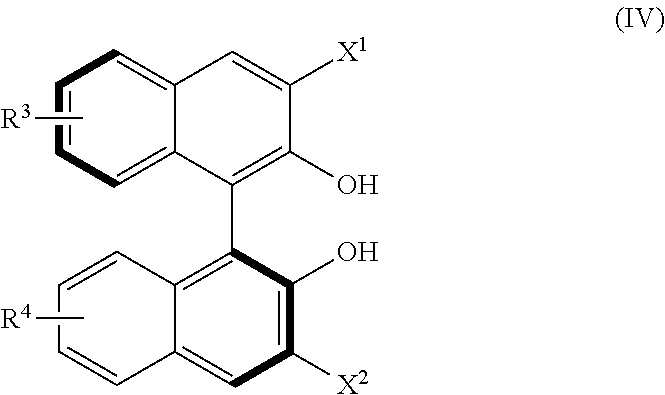Process for asymetric methylallylation in the presence of a 2,2′-substituted 1,1′-BI-2-naphthol catalyst
a technology of asymetric methylallylation and asymetric methylallylation, which is applied in the preparation of hydroxy compounds, chemistry apparatus and processes, and organic chemistry. it can solve the problems of triphosgene, high toxic reagent, and low yield of desired diastereomer (b)
- Summary
- Abstract
- Description
- Claims
- Application Information
AI Technical Summary
Benefits of technology
Problems solved by technology
Method used
Image
Examples
example 1
Preparation of (S)-3,3′-difluoro-1,1′-binaphthyl-2,2′-diol (3)
[0112]
Step 1: Synthesis of (S)-2,2′-bis(methoxymethoxy)-1,1′-binaphthyl (4)
[0113]
[0114]A solution of (R)-1,1′-binaphthyl-2,2′-diol (30 g, 0.10 mol) in THF (200 ml) is added to a stirred slurry of 60 wt % NaH (10.48 g, 0.26 mol) in THF (100 mL) at 0-10° C. The mixture is stirred 1 hour and treated with chloro(methoxy)methane (MOMCl) (20.25 g, 0.25 mol) while maintaining the temperature below 10° C. The resultant mixture is stirred for 1 hour at 0-5° C. then treated with water (100 mL) to quench the reaction. The organic phase is collected and the aqueous phase extracted with EtOAc (2×250 mL). The combined organics layers are washed with water (200 mL) and concentrated. The resultant pale yellow solid is then slurried in 10:1 (vol / vol) hexane / EtOAc. The solids are collected by filtration and dried under reduced pressure to provide 4 as a white solid. Yield: 38.5 g, 98%.
Step 2: Synthesis of (S)-3,3′-difluoro-2,2′-bis(methoxy...
example 2
Synthesis of 5,5-dimethyl-2-(2-methylallyl)-1,3,2-dioxaborinane (6)
[0119]
[0120]A reactor is purged with N2 and charged with magnesium turnings (29.16 g, 1.21 mol) and dry THF (1 liter). The contents of the reactor are maintained at 20-25° C. and treated with a 1 M solution of DIBAL-H in heptane (33.1 mL of solution; 0.03 mol of DIBAL-H) followed by slow addition of 3-chloro-2-methyl-1-propene (100.0 g; 1.10 mol). The resultant mixture is maintained at 20-25° C. for 2 hours and filtered to provide the Grignard reagent. (Typical yield of Grignard reagent is 85%.) The resultant filtrate is treated with methyl-t-butyl ether (370.0 g, 4.2 mol), cooled to −65° C., and treated with trimethylboronate (80.0 g, 0.77 mol) while maintaining a temperature of less than −60° C. The resultant milky solution is maintained at −55 to −60° C. for 30 minutes and slowly warmed to 0° C. over 30 minutes. The mixture is then treated with acetyl chloride (54.4 g, 0.69 mol) while maintaining a temperature of ...
example 3
[0121]Compounds 1, 2 and 3 can be used to carry out the asymmetric methylallylation as depicted below:
[0122]
[0123]Asymmetric methylallylation using the compounds of formula 1, 2, or 3
[0124]
[0125]General procedure for the catalytic asymmetric methylallylation using compound 3 to prepare (R)-1-chloro-5-methyl-3-phenylhex-5-en-3-ol (8): A N2-filled flask is charged with 3-chloro-1-phenyl-butan-1-one (7) (10 g, 58 mmol), t-amyl alcohol (5.12 g, 58.11 mmol), and compound 3 (0.56 g, 1.7 mmol). The reaction mixture is maintained at a temperature of about 23° C. and treated with 6 (14.51 g, 81.4 mmol) and stirred for about 22-24 hours. Samples of the reaction mixture are removed periodically and the reaction progress monitored using HPLC or infrared spectroscopy. (See Ex 3d in the Table below.) After 24 hours compound 8 is present in 88% yield. The selectivity is about 88:12 favoring the R-isomer (determined by the HPLC method described below). Compound 8 is isolated from the reaction mixtu...
PUM
| Property | Measurement | Unit |
|---|---|---|
| temperature | aaaaa | aaaaa |
| reaction time | aaaaa | aaaaa |
| temperature | aaaaa | aaaaa |
Abstract
Description
Claims
Application Information
 Login to View More
Login to View More - R&D
- Intellectual Property
- Life Sciences
- Materials
- Tech Scout
- Unparalleled Data Quality
- Higher Quality Content
- 60% Fewer Hallucinations
Browse by: Latest US Patents, China's latest patents, Technical Efficacy Thesaurus, Application Domain, Technology Topic, Popular Technical Reports.
© 2025 PatSnap. All rights reserved.Legal|Privacy policy|Modern Slavery Act Transparency Statement|Sitemap|About US| Contact US: help@patsnap.com



